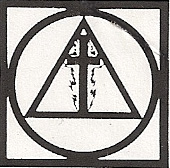Now when the centurion saw what had taken place, he praised God and said, “Certainly this man was innocent!” And those who were with him keeping watch over Jesus, seeing the earthquake and what took place, were filled with awe and said, “Truly, this man was the Son of God!” And all the multitudes who were assembled to see the sight, when they saw what had taken place, returned home beating their breasts.
The Gospel of Nicodemus relates:
“The centurion went to the governor and related to him all that had passed, and when he heard all these things, he was exceeding sorrowful; and calling the Jews together, he said to them, ‘Have you seen the miracle of the sun’s eclipse and the other things which came to pass while Jesus was dying?’”
All nature shared in the grief of this occasion as shown by the symbolic rending of the sacred veil. The Holy of Holies, which normally excluded by its veil all but the high priest on his once-yearly visit, was now opened, as though to unveil all religions and temple mysteries.
The Jews and the elders and the priests, when they perceived what great evil they had done to themselves, began to lament and to say, “Woe for our sins; the judgment and the end of Jerusalem has drawn near.” (According to the Gospel of Peter.)
And all his acquaintances and the women who had followed him from Galilee stood at a distance and saw these things. The soldiers did not permit people to stand too close at such times, lest they interfere.
Since it was the day of Preparation, in order to prevent the bodies from remaining on the cross on the Sabbath (for that Sabbath was a high day), the Jews asked Pilate that their legs might be broken to hasten death, and that they might be taken away. This was also according to their law as given in Leviticus:
“If a man has committed a crime punishable by death and he is put to death and you hang him on a tree, his body shall not remain all night upon the tree, but you shall bury him the same day, for a hanged man is accursed – you shall not defile your land . . .”
It was the final indignity for the Son of God to be counted as “accursed,” and numbered among the transgressors – he who had begun life in a stable and had been forced to flee to a foreign land to remain alive.
So the soldiers came and broke the legs of the first, and of the other who had been crucified with him; but when they came to Jesus and saw that he was already dead, they did not break his legs. But one of the soldiers, called Longinus, pierced his side with a spear, and at once there came out blood and water. Then Mary remembered the words which Simeon had spoken in the temple, when the infant Jesus was carried up to have sacrifice offered for him. Simeon had said to her then:
“Behold, this child is set for the fall and rising of many in Israel,
And for a sign that is spoken against;
And a sword shall pierce your own heart also,
That thoughts out of many hearts may be revealed.”
And in her heart she too must have echoed, “It is finished.”
In this experience, Mary, unsung and unheard, suffered the ultimate crucifixion of womanhood at the same time that Jesus gave the ultimate gift of his own life. And she thereby gained the fullness of compassion for the sorrows of other women, and for the crucifixion of the human heart.
In the words of John: He who saw it has borne witness – his testimony is true, and he knows that he tells the truth – that you also may believe. For these things took place that the scripture might be fulfilled, “Not a bone of him shall be broken.” And again another scripture says, “They shall look on him whom they have pierced.” –From The Story of Jesus
